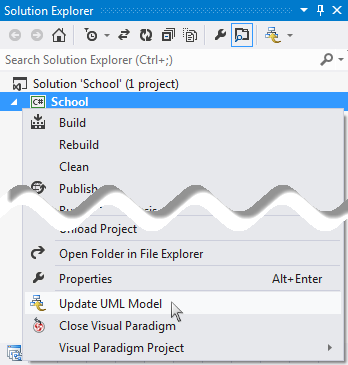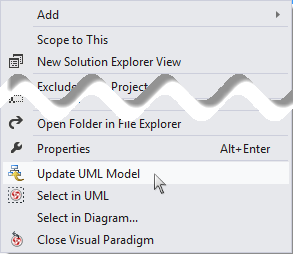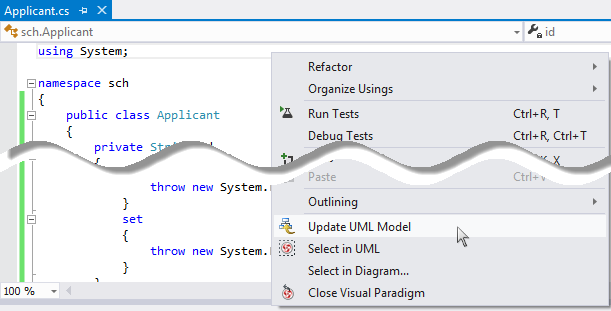How to Reverse Engineer UML Model in Visual Studio?
Reverse engineering is the process to reverse engineer UML model from source files in Visual Studio project. With reverse engineering you can visualize your program or system with class diagram. Before reverse engineering, you must open the UML project from the Visual Studio project.
Project Based Reverse Engineering
You can produce and update UML models from all source files in a Visual Studio project. Models of the selected project, child namespaces and classes will be created (if the models are not already exists) or updated. To reverse engineer from an Visual Studio project, right-click on the project node in Visual Studio and select Update UML Model from the popup menu.
 |
| Update the whole UML project from a Visual Studio project |
Namespace Based Reverse Engineering
You can produce and update UML models from source files under namespace. Models of the selected namespace, child namespaces and classes will be created (if the models are not already exists) or updated. To reverse engineer from a namespace in a Visual Studio project, right-click on the namespace in any tree and select Update UML Model from the popup menu.
 |
| Update UML package and its containing classes from a namespace folder |
Class Based Reverse Engineering
You can produce and update UML models from classes in Visual Studio. Models of the selected class and child classes (inner class) will be created (if the models are not already exists) or updated. To reverse engineer code from a class in a Visual Studio project, right-click on the class file in any tree or in code editor and select Update UML Model from the popup menu.
 |
| Update UML model from source file |
Related Resources
The following resources may help you to learn more about the topic discussed in this page.
- Tutorial - Generate C# source from UML class diagram in Visual Studio
- New to Visual Paradigm? We have a lot of UML tutorials written to help you get started with Visual Paradigm
- Visual Paradigm on YouTube
- Visual Paradigm Know-How - Tips and tricks, Q&A, solutions to users' problems
- Contact us if you need any help or have any suggestion
| 3. Opening a UML Project in Visual Studio | Table of Contents | 5. Code Generation from UML Model in Visual Studio |
